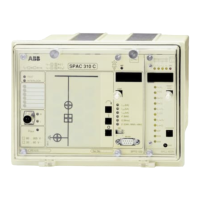18
The control module SPTO 1D2 has five out-
puts: three signal outputs (SIGNAL1…3) and
two control outputs (OPEN and CLOSE). For
programming the outputs are coded in the fol-
lowing way:
Output Output Remarks
code
OPEN 20 For configuration
and interlocking
OPEN 220 For Conditional
Direct Output
Control
CLOSE 21 For configuration
and interlocking
CLOSE 221 For Conditional
Direct Output
Control
SIGNAL1 22
SIGNAL2 23
SIGNAL3 24
The OPEN and CLOSE outputs can be con-
trolled in four ways:
- Locally by using the OPEN and CLOSE push-
buttons
- Remotely by commands over the serial bus
- Remotely via the binary inputs 4…13, see
chapter "Input channels 4…13"
- By the Conditional Direct Output Control
logic, see chapter "Conditional Direct Output
Control"
To define the object to be controlled via the
outputs OPEN and CLOSE, see chapter "Con-
figuration".
When using the three first ways of operation the
OPEN and CLOSE outputs give pulses. Before
the output is activated the interlocking logic
must enable the operation.
The pulse lengths for opening and closing out-
puts are defined with the SPA bus variables V5
and V6. The definitions have to be made only
for the channel on which the object to be
controlled is located. As a default the object to
be controlled is located on channel 2.
The pulse lenght can be set in the range 0.1...
100 s with a time resolution of 0.1 s. As a default
the values for V5 and V6 of channel 2 are 0.1 s.
Example 11: The pulse lenghts can be pro-
grammed in the run mode. In default configu-
ration 1 the object to be controlled is defined to
be a CB in channel 2. To change the open and
close pulse lengths from 0.1 s the following SPA
bus commands are used:
>99W2V5:0.5:XX
; Set the open pulse length to 0.5 seconds
>99W2V6:0.2:XX
; Set the close pulse length to 0.2 seconds
>99WV151:1:XX
; Store the programmed parameters
The open and close commands are given via the
serial communication to the channel on which
the object is located. The OPEN and CLOSE
outputs can be controlled via the serial commu-
nication by using two different procedures:
- Direct control: An output command is given
by using the parameter O1. When the param-
eter has been given the value 0 (open) or 1
(close) the corresponding output pulse is de-
livered, if enabled by the interlocking.
- Secured control: First an output is set into a
state of alert by using parameter V1 for open-
ing and parameter V2 for closing. After that
the corresponding output command is ex-
ecuted by using parameter V3. The output
pulse is given if the interlocking enables it.
The state of alert is cancelled after the execute
command. The state of alert can also be
cancelled by using parameter V4.
When the Conditional Direct Output Control
logic is used for controlling the OPEN and
CLOSE output, the output is activated as long
as the statuses of the inputs which have caused
the operation remain unchanged.
The operation of outputs OPEN and CLOSE
can be inhibited in two ways:
- By the interlocking program logic, see chapter
"Interlocking"
- By input channels 4…13, see chapter "Input
channels 4…13"
The outputs SIGNAL1…3 can be controlled in
two ways:
- By input channels 4…13, see chapter "Input
channels 4…13"
- By the Conditional Direct Output Control
logic, see chapter "Conditional Direct Output
Control"
The control module SPTO 1D2 includes a self-
supervision system which has its own output,
IRF. The output is active when auxiliary power
is connected and the self-supervision system has
not detected any fault. The output signal goes
low if the auxiliary power supply is switched off
or a permanent fault is detected. The self-super-
vision output is connected to the common IRF
output of the feeder terminal.
Outputs

